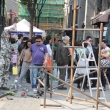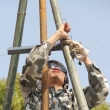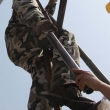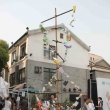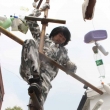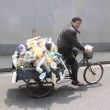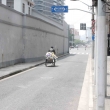Two perspectives
Scientists might approach this question by isolating cases where biological evolution is accelerated (for instance animal breeding programs) and observing changing social behaviors, or conversely isolating cases of accelerated social change (i.e. cultures disturbed by foreign contact) and observing signs of biological change. Sociobiologists have a special interest in this kind of inquiry. Whatever the approach there are wide possibilities for discovery.
Separate from this deductive line of thinking, however, one might just consider the individual, who constitutes simultaneously a body composed of mutating genes and dividing cells and a person who through continuous decisions and interactions is composing society. From this perspective, the distinction between biological and social is subverted by an awareness of a continuum of relationships. For the biologist Gregory Bateson “news of difference” (i.e. information) is the basic condition of all life on which these relationships are established.
[To become aware of this principle operating within oneself] “is to become in a curious way much closer to the world around you. The word “objective” becomes, of course, quite quietly obsolete; and at the same time the word “subjective,” which normally confines “you” within your skin, disappears as well. (quoted from his afterword to About Bateson (1977))
The artist in each of us
Cultivating this ecological perspective is specially relevant for creative societies, for what is revealed when “objective” and “subjective” drop away is the domain of the creative. Essentially, there is an artist in each of us that is called upon to create composite pictures from the shower of information that comes from “within” and “without”, and thereby provide a footing for our actions. Whether we are aware of it or not this creative process is perpetually at work, putting in motion changes in our society as well as our own biology.
As such, the challenge for creative societies is not so much learning to be creative but learning to be more so, and most especially learning to creatively influence our own creative processes. As Bateson suggests, becoming aware of this process is a good start. Artists are especially helpful in this, for among the acts that take place around us those of artists are unique in symbolizing creativity itself. Watching an artist at work is like peering into some aspect of ourselves: aside from the specific manifestations of their creative visions, they turn us back on the question of what is the nature of all creativity?
Urban DNA
To take a concrete example, the sculptural installation Urban DNA was erected by the artist Xu Zhifeng recently in an outdoor courtyard in Shanghai as part of the weekend-long Ecodesign Fair. Since the sculpture was not actually completed until the final hours of the fair, the scene that was revealed to most visitors was of a gradually emerging semblance of order imposed on a field of chaotic disarray. Steel pipes, wire, garbage, assorted tools and hardware were strewn about at the start of the weekend. Even so, visitors lingered, captured by the striking form of the artist moving purposefully about in his overalls. Various conjectures and suggestions were voiced as the structure began to take shape. Around noon of the first day the center pole was mounted on a tightly designed base, and it became evident that the artist was creating something very high.
A DNA strand is very remote from our senses, but what we know of its structure has such a strong aesthetic resonance that even a textbook illustration makes an indelible imprint on our minds. The juxtaposed swirls that answer the paradox of stability and dynamic change seem almost intuitive. Yet of course the processes underway there are deeply complex. Side by side with the miracle of evolution lie the mysteries of cancer, alcoholism, obesity, bad complexion, unruly hair and so on.
Through the second day of the fair Xu Zhifeng could be seen leveraging himself against the cross-bars at the upper reaches of his armature, straining to adjust a double helix of plastic bottles, candy wrappers and other residual items of the city. His improvised movements and the materializing spiral of forms itself shook any impression that this was some kind of protest statement about careless waste. Instead a more elemental suggestion was emerging: that our cities and our bodies are, for better or for worse, what we make of them. His creative presence throughout the weekend was a joyful demonstration that we can actively embrace this work, as well as a distracting stimulus for reconsidering the many possible ways to evolve.

